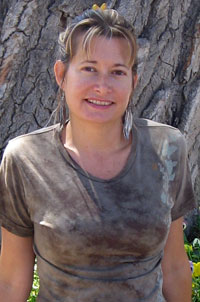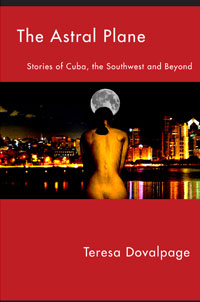This week, TheLatinoAuthor.com is interviewing author Teresa Dovalpage who was born in Havana and now lives in Taos, New Mexico. She has a PhD in literature and currently teaches at UNM-Taos. She also writes a weekly column for the local newspaper, Taos News. A bilingual author, she has published six novels, four in Spanish and two in English, and three collections of short stories.


Can you tell us a little bit about yourself and your background?
I was born in Havana, Cuba, and considered a bookworm since my childhood. Had I been here I’d have been called a nerd, I guess. I wrote my first short stories when I was a teenager and couldn’t stop afterwards. My first published book was the novel A Girl like Che Guevara (Soho Press, 2004), followed by Posesas de La Habana (Pureplay Press, 2004). I felt encouraged after that and started calling myself a writer. J Before, I didn’t dare to! Now I have six novels and three short story collections published. I live in Taos, a beautiful and quirky town near the Sangre de Cristo Mountains, in New Mexico, and I teach at UNM Taos.
You have published three collections of short stories, several novels, and are also a playwright. Which of these styles of writing do you prefer or are they equal in nature?
It depends on the story. There are some that come to me (“through” me, sometimes) as novels. Others are definitely short stories. And finally, some come to me as theater plays, complete with the characters’ voices and stage directions.
Of the three different types of writing, which do you find the most challenging and why?
Theater, definitely. One thing I have learned is that theater is more than dialogue. Much more. One also has to be realistic about the staging possibilities…I included a cat in Hasta que el mortgage nos separe. The poor directors had to get creative! Rosario Vargas, from Aguijon Theater, used a stuffed animal and Marcelina Gallegos, from UNM, a kid who “played” the cat.
Your literary works have been written in both Spanish and English. When you begin your writing process, how do you determine which of these languages you’re going to use for that particular literary work?
At first it wasn’t a matter of choice. I wrote my first novel in English because I thought, “I’d better write in English if I want to be published and read here.” Later I discovered the Hispanic and Spanish markets (gracias, San Google!) and I continued alternating between the two languages. Now, I generally write in the language in which story comes to me. In the case of The Astral Plane, Stories of Cuba, the Southwest and Beyond (UNO Press, 2012), some of the stories are set in New Mexico, so it felt more natural to write them in English.
Which of your stories was the most difficult to write and why?
Probably Muerte de un murciano en La Habana, published in 2006 in Spain, and a finalist for the Herralde Award. I struggled to find the narrative voice until I discovered that more than one was needed, so it has an omniscient narrator and several monologues of the main characters. I even included myself in it, just for grinsies.
In your book Habanera: A Portrait of a Cuban Family you write about a post-revolutionary time. How much was taken from personal experience and how much was fictional?
It started as a memoir, but at a given moment I realized I had reinvented history too much. After some prodding from my mother, who called me a liar among other things, I decided to turn it into fiction. The novel is loosely based on my own family, though I added many events that never happened in reality. (There was no ghost at home, at least that I knew of.) But all the characters are inspired in my family, which is a motley crew, myself included.
Just recently you published La Regenta en La Habana. Can you tell us a little bit about this book?
It’s a rewrite of the final chapters of La Regenta, by Leopoldo Alas, (Clarín). In this classic nineteenth century Spanish novel, Ana Ozores, the main character, is married to a much older man and courted by the local Don Juan and by a priest, Don Fermín. My novel has two parallel plots: one about Yoana, a University of Havana professor who is teaching La Regenta in her literature class, and the rewrite of the original novel’s last chapters, done by Yoana as a soul-searching exercise. I don’t know what the critics of Clarín’s work would say about my book but I had tons of fun writing it!
How difficult was it to get your works published, and what advice can you provide to our readers in this arena?
I think I lucked out with my first novels. I sent the ms. of A Girl like Che Guevara to Soho Press, unagented, and they bought it. The same happened with Posesas de La Habana and PurePlay Press. Now I have an agent in Spain and I am very happy with her. I have more time to write and don’t have to worry about peddling my books. But I still like marketing and also enjoy promoting my work. So my advice to writers is, get an agent (that always helps a lot) but in the meantime, try to sell your books on your own.
Who or what inspires you to write?
My crazy family life—I mean my Cuban family life. Dysfunctional families are wonderful sources of inspiration, especially when one is far away and can look at them with detachment, and even laugh at things that used to be exasperating or embarrassing. My friends. The places where I live. The places that I visit, and the people, particularly the quirky ones… there is a great deal of quirkiness in Taos, which makes it a great place for a writer. Traveling also inspires me. Last Christmas my husband and I went to the Gutenberg Museum and I left thinking of a story.
What do you want your readers to take away after having read your works? In other words, what do you want to be remembered for as a writer?
I want to entertain my readers. I want them to spend a good time while reading my stories, and if in the process they learn something new and interesting about, let’s say, Cuba, that’s icing on the cake.
Can you share some upcoming projects that will be forthcoming in the near future?
As I said, I love marketing. I am putting together a collection of articles I wrote for Taos News and will publish them in Amazon as a book—a comprehensive guide to Taos. The articles are already written so now comes the fun part, letting people know about the book!
Contact: http://teredovalpage.wordpress.com




